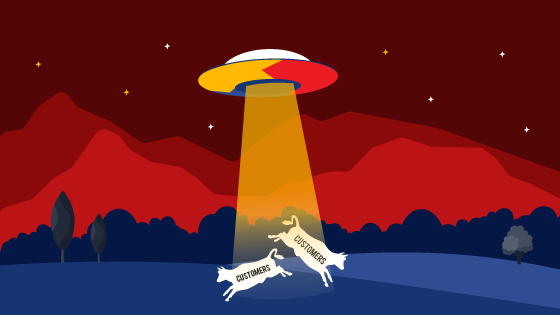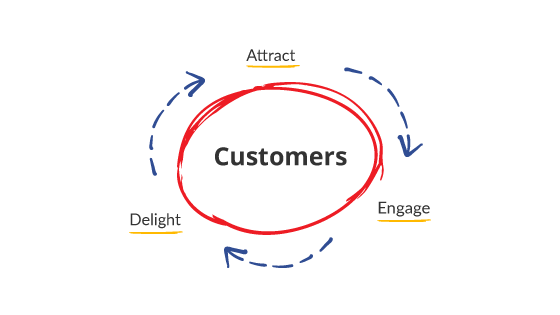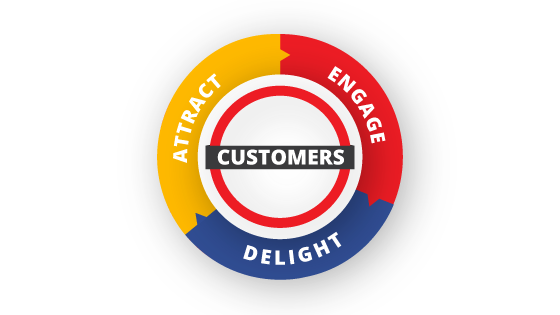What Is Inbound Marketing and How Can It Help My Business?
Brass Tacks: Inbound marketing turns prospects into leads by providing ways that customers can connect to you as a brand. By continuing to provide value before, during and after your customers have made a purchasing decision, you'll keep them coming back!

Let's get into the details how this happens
Here's what we'll cover:
- What are three main forms of marketing?
- What is Inbound Marketing?
- How will Inbound Marketing Help your Business to grow?
- What Inbound Strategies are more Effective for your Business?
What are the three main forms of marketing?
Marketing in its classic form is all about generating leads, then passing them over to sales.
The outbound method is going out to find your leads. Let’s say you have a company that provides fun activities for kids during the holiday season during corona. Remember in outbound, you go to find leads yourself.
So you may want to think of purchasing a call list to cold call or spending time and money on a YouTube ad that pops up in the middle of your prospects television show or YouTube program.
Inbound marketing is different from its counterparts. Here's how: In the age of Google, inbound marketers recognizes that customers are more educated than they ever were in the past. Your customers are actively researching ways on Google to solve their problems.
What’s Inbound Marketing?
How does HubSpot (The best CRM out there today) define inbound marketing?
“Inbound marketing is growing your organization by building meaningful and lasting relationships with consumers, prospects, and customers. It’s about valuing and empowering these people to reach their goals at any stage during their journey with you. When your customers succeed, your business succeeds with them!"
- “What is Inbound Marketing? https://www.hubspot.com/inbound-marketing)
Ok, so let's use the example of marketing kids activities, but this time we’ll put our inbound marketing hat on. You may want to think of putting a blog post on 10 great ways of engaging your kids during the holidays during COVID-19.
Let’s say a week goes by and one of your prospects finds your blog post on the top of Google’s search results page. Super, so you have a fab blog, but that’s not the only thing you’ll need.
Once your prospects get to your blog post, you’ll want a CTA (Call to Action) with a downloadable content offer - or something else - enabling them to leave their details so you can follow up with them later!
Next, we’ll look at the inbound engine in detail, starting with the three stages of:
- Attract
- Engage
- Delight

How do you apply Inbound?
HubSpot, leaders of Inbound Methodology apply it in three progressive stages:
Attract: draw the right people in by providing valuable content that solves customers problems. For example, your blog on 10 fun activities that your kids can do during COVID.
Engage: It’s not enough to attract customers with your content, you have to go one step further in providing them some ways of connecting with your brand.
For example, a calendar that your customers can use to plan activities for their kids a whole week or month. Or if your customers are looking for a fashionable, affordable custom made suit or dress, providing a downloadable guide to the latest summer fashions.
Something where people can leave their details in exchange for a valuable content offer or an opportunity to try out a new product or service.
Delight: To continue to provide value before, during, and after a customer has made a purchase. Going one step further than what your customer is expecting.
For example, this could be sending out a survey 6 months after your customer has bought a product or sending an email of a newly improved offer than what your customer previously purchased from you in the past. When customers see that you are going above and beyond the call of duty, they will be advocates for your company.
This is why inbound marketing sets a firm foundation for your businesses’ growth.
Next - flying over to the flywheel -
What is the flywheel and how does it help you?
No, it’s not the top of a colorful spaceship :)

James Watt is the originator of the flywheel. Yes, you’ve seen his name before; he is also the inventor of the common light bulb. A flywheel is simply a wheel or disc on an axis that’s very energy efficient.
The amount of energy a flywheel stores depends on how fast you spin it, how much friction there is, how heavy it is and its weight. Many of today’s cars, trains and power plants use flywheels. A couple of years ago HubSpot’s CEO, Brian Halligan began speaking about how a flywheel can be used as a growth model for businesses.

The flywheel in its role as a growth model focuses on creating exceptional experiences for your customers. By investing in strategies to add and retain customers, the faster your flywheel spins.
How to make the flywheel keep on turning and growing?
To avoid your slowing down or friction in your flywheel, you need to make sure that there is fluid communication and alignment between each of your teams.
For example, making sure the hand off between marketing and sales is super efficient. Let’s say a customer clicks on a CTA on your landing page or your blog post, indicating they are interested in finding out more about a specific product or product trial.
The CTA directs them to a form where they can fill in their details. A few moments later, a member of your sales team contacts them. Your customer leaves the conversation feeling better informed and better equipped to make a purchasing decision. This results in this lead becoming a customer.
Then you send a survey in a few months time to evaluate your customer’s satisfaction with the product and your services. The consequence of you going above and beyond what your customer expects, is they’ll tell their friends. Your wheel turns faster and grows, and so does your business!
To learn more about the flywheel check out Hubspot’s free lesson on the flywheel
What Are Strategies In The Flywheel’s Stages That’ll Propel Your Business?
Attracting Strategies
There are three types of strategies related to the phases on the flywheel. Inbound strategies that attract your target audience and buyer personas are bound together with content that you’ll create.
This includes your blog articles.
- Blog posts such as listicles such as “10 great ways to engage your kids during the holidays”.
- How to style blogs that focus on solving customers' problems like “How to engage your kids during the summer where everything is closed because of COVID-19 restriction.
- They can also be in the form of customers' testimonials like “We had great fun doing these activities, they’re super safe and great for kids”.
Definition of a buyer persona: A buyer persona is a semi-fictional description of your ideal customer; this involves a combination of market research and real data about your existing customers. It also includes customer demographics, their behavior patterns, and their goals.
Engaging Strategies
Engaging strategies are all about providing places where customers can connect to you as a brand so you can get their information. Frank Isca writing for weidert.com says the engagement stage is like “you're greasing the wheels for them (your leads) so they can make a purchase decision”.
Content plays a slightly different role here, you may want to offer content offers such as
- Calendars which act as activity planners for work or at home,
- Informational and educational” How to” Guides.
- Social Media calendars.
- Webinars.
- Product demos.
Anything that can make the decision to buy from your company that much easier.
Another great strategy is using a live chat window enabling your leads to ask their question to a real human being on the other end. It could be one of the experienced members of your customer service team that manages the chat. An alternative example is to offer them free trials, making it easy for your customers to experience your product or service.
Delighting Strategies
Delighting strategies ensure that your customers are happy, satisfied, and supported long after they've purchased a service or product from your company. In any delighting strategy, your team plays the role of experts and advisors when your customers need something else or have an interest in the new services you offer.
HubSpot says that a great way to delight your customers is by using thoughtful and well-timed chatbots and surveys to support, assist, and ask for feedback.
Another great tool is social media listening so you can provide feedback and answer your customers questions about your products or services. When they see that you respond in a timely manner to their queries, it’ll make them feel like you care.
This may not result in them purchasing anything this time, but they’ll remember any effort that you make will be logged in their memory. When they are ready to buy something again, they’ll be sure to reach out to you.
Our Bottom Line:
Inbound marketing helps you help your customers. First by attracting the customer to your blog, then by creating some way that customers can connect to you as a brand so you can get their information. Then once they become your lead to continue to add value to them so that before, during, and after they’ve made a purchase decision they end up realizing what a great ally you are to them and how helpful you are.
Your Articles Need SkimCatchables
Skim-Catchables are bloggers' - now- not-so- secret weapon to make readers' jobs easier because they can easily skim down a page and find the answer to what they are looking for. Engaging titles and subtitles, gorgeous infographics, and functions like TL; DR (Too long; didn’t’ read) not only help readers, but should be part of any writer's tool kit!
Topic #Content Marketing,#abilitySEO,#inbound,#building trust,#SEO trends,#chat bot,#CTA,#flywheelJonathan Gordon is the chief writer and PR liaison for an HR firm. His passions are creating inspiring and engaging content. Jonathan has a love for learning about new industries and acquiring new skills. Jonathan is also a trained classical and jazz pianist and loves meeting new people and is open to new experiences.

Leave us
a Comment!